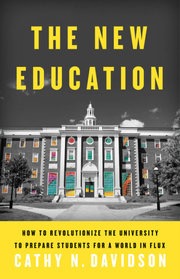
1 Selected Items
Select an item by clicking its checkbox
The New Education: How to Revolutionize the University to Prepare Students for a World In Flux
Date Reviewed: August 7, 2018
Cathy N. Davidson’s The New Education: How to Revolutionize the University to Prepare Students for a World in Flux is an engaging, enlightening, and empowering call to action. Though its focus is on why and how to transform higher education to meet the needs of today’s students and society, it offers commentary on innovative and effective pedagogy that will be of special interest to Wabash Center readers.
If you only have time for a condensed version of Davidson’s recommendations for improving college teaching, read the “Ten Tips for Transforming Any Classroom for Active Student-Centered Learning” (263-67). Davidson lauds 10 techniques: Think-Pair-Share, Question Stacking, Everybody Raise Your Hand, Interview, Class Constitution, Collective Syllabus Design, Collaborative Note Taking, Collaborative Projects with Peer Assessment, Exit Tickets, and Public Contribution to Knowledge. In keeping with Davidson’s central thesis, these techniques serve to invigorate learning in college courses, but their ultimate value is that they best prepare students for life beyond the college gates.
Indeed, it is the demands of modern life that prompts Davidson to argue for radically revising the university. America’s system of higher education has reified, she argues, the vision of Charles Eliot, president of Harvard in the late 1800s. Eliot sought (most notably in his essay entitled “The New Education” from which Davidson takes her title) to transform America’s colleges from seminary systems to institutions designed “to train farmers and shopkeepers to be factory workers and office managers” (3). In pursuit of this goal, Eliot, and fellow educational reformers, established the university as we know it:
- majors, minors, divisions (humanities, social sciences, natural and biological sciences), credit hours, degree requirements, grades, the bell curve . . . class rankings, certification, general education, upper-division electives, . . . professionalization (credentials, accreditation), graduate schools . . . financial aid, college entrance exams . . . tenure . . . school rankings . . . (35-36)
and more. By 1925, Eliot’s vision (shaped by his study of German and French models) dominated the landscape of American higher education.
Not much has changed, Davidson laments. These features continue to define the college experience for most Americans. But now, they come with anemic “teaching to the test” at all levels of education, crushing student debt, and graduates narrowly trained for specialties that are fast disappearing in the technology-laden world in which we live.
Against the current state of affairs, Davidson argues for pedagogy and universities to center on students and aim at preparation for life, not just careers. Davidson documents how the shift from the Industrial Age to our current age (which she dates at 1993 with the dawn of the Internet) has yet to be taken seriously by academics. Doing so, she insists, demands radical rethinking of the college experience.
To illustrate the types of changes she advocates as proper responses to the technological age, Davidson points to community colleges and initiatives at universities. LaGuardia Community College in NYC, Arizona State University, and The Red House at Georgetown University receive the lion’s share of her attention. And for good reason. Education at these schools is being rethought and retooled to serve the student and his/her future needs. Actually, as Davidson notes, community colleges have been doing this all along. Founded to serve non-elite students, community colleges succeed by proceeding “from a pedagogy of acceptance. Any growth constitutes success. The student is at the center” (57).
Although active learning and student-centered pedagogy benefit students, it is not risk-free. Fear of “losing status” causes many professors and institutions to shy away from adopting the mindset and support systems community colleges embrace. To illustrate the risks, Davidson recounts the story of Alexander Coward, formerly of Berkeley . . . formerly because allegedly his student-centered pedagogy did not sit well with his colleagues (208-210).
In addition to the aforementioned “Ten Tips,” those primarily interested in pedagogical issues should read Chapter 3, “Against Technophobia,” and Chapter 4, “Against Technophilia.” Within these two chapters, Davidson offers many, many helpful hints for how to use technology imaginatively and effectively in the classroom.